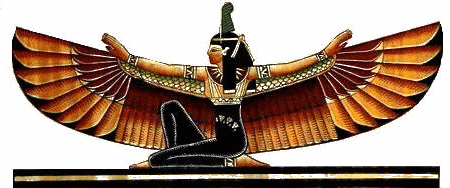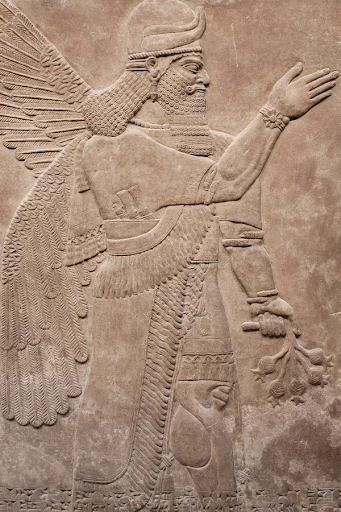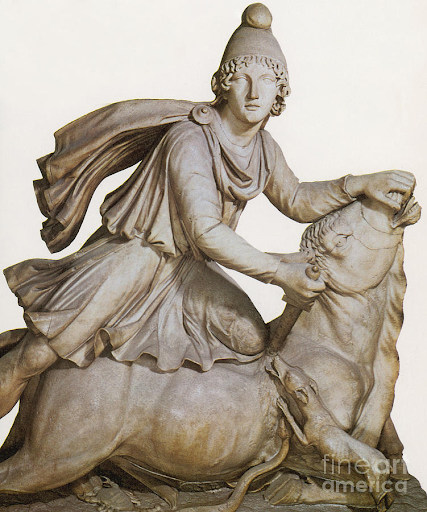Second, there exist numerous parallels and similarities between descriptions and cultic terminology used for El in the Canaanite texts and those used for Yahweh in the biblical sources (see below). At some point, it is ascertained, the cultic worship of Yahweh must have absorbed that of El, through which means Yahweh assimilated both the imagery and epithets once used of El.
Finally, there is strong confirmation of this assimilation in the biblical record itself.
In the oldest literary traditions of the Pentateuch, it is El who regularly appears and not Yahweh, or Yahweh as El! The patriarchal narratives identify El as the deity to whom many of the early patriarchal shrines and altars were built. For example, we are informed in Genesis 33:20 that Jacob builds an altar in the old cultic center of the north, Shechem, and dedicates it to “El, god of Israel” (’el ’elohe yišra’el ). There is no ambiguity in the Hebrew here: ’el must be translated as a proper name, El.3 The textual tradition from which this text derives, the Elohist, ultimately remembers a time when El was the patron god of Israel.
That El was the deity worshiped at Shechem is also attested in Judges 9:46, which speaks of the shrine of “El of the covenant.” The god of the shrine at Bethel, which literally translates, “house of El,” is additionally El—”I am El of Bethel” (Gen 31:13; cf. 35:7)—and appears to Jacob as El Shaddai (35:11; cf. 48:3). Jacob has another encounter with El at Penuel, which is so named because Jacob sees El face-to-face (32:31).
Moreover, Isaac blesses Jacob through El Shaddai (28:3), and likewise Jacob blesses Joseph “by El of your fathers” (49:25). “El who sees” is given as the etymology of Beerlahai-roi in Genesis 16:13. And we are informed that Abraham journeys to the old cultic shrine at Beersheba, where he plants and worships a tree and calls on the name “El the eternal” and at the same time Yahweh (Gen 21:33). Contrary to Genesis 33:20, where the Shechemite El is presented unambiguously as the “god of Israel,” in Genesis 21:33, El is apparently already assimilated to Yahweh (see below). Finally, Genesis 14:18-22 speaks of “El the most high,” of whom the Canaanite Melchizedek is priest at Jerusalem.
This assimilation between Yahweh and El, or El into Yahweh, is present in much of the Priestly material as well. In fact, the Priestly source largely advocates this assimilation. In Genesis 17:1, the Priestly writer states that “Yahweh appeared to Abram and said to him: ‘I am El Shaddai.’” And Exodus 6:2-3, in contradiction to J (#11), has Yahweh assert: “I am Yahweh. And I appeared to Abraham, to Isaac, and to Jacob as El Shaddai, and I was not known to them by the name Yahweh.” Although the verse suggests an identification between Yahweh and El “of the mountain,” the verse also subtly recognizes an ancient distinction between the god of the patriarchs (El) and the god of the Mosaic era (Yahweh). But the assimilation is clear here: the patriarchs who worshiped El in the past were actually worshiping Yahweh, claims the Priestly writer.
Perhaps it is necessary at this point to ask: Who was El? And why is he even mentioned in the Bible in the first place, let alone as the god of Israel in the older literary traditions of Genesis?
Our knowledge of El predominantly comes from an invaluable corpus of tablets discovered in 1929 in the ancient city of Ugarit, a major city-state of the second millennium BC located on the northern coast of Syria, modern day Ras Shamra.4 The Ugaritic tablets are the best available witness to Canaanite religion and religious practices, and thus also “to the background from which the religion of Israel emerged, and to the Canaanite beliefs that it shared, adopted, compromised with, and sometimes rejected.”5 The Ugaritic literature depicts El as the sovereign deity of the Canaanite pantheon. He is frequently referred to as “Father of the gods,” “the eternal King,” and “Creator of all living beings.” El’s other epithets include: “El the Kind, the Compassionate,” “the Bull,” “the Ageless One,” and “the Father of Years.” He is depicted as bearded, and residing in a tent or a tabernacle, whose throne rests on Cherubim. He is the god of blessings and of covenants.
Many of these epithets and images later become assimilated to Yahweh. For example, Yahweh is often depicted as bearded, as King of the gods, as Compassionate, and as residing in a tent, whose throne, like that of El, rests on Cherubim. There are, in addition to this, numerous El epithets in various strains of biblical tradition—epithets that through a process of assimilation and adoption later become associated with Yahweh. We have already encountered El Shaddai, “El of the Mountain.” Like Yahweh who is associated with the mountain of Sinai and later in eschatological traditions with Zion, so too El resides on a mountain. Other patriarchal narratives attest the use of El Olam, “El the Eternal” to whom Abraham plants and worships a tree at Beersheba, El Elyon, “El the Most High,” the god of Melchizedek (Gen 14:18-24), and El Roi, “El who sees” (Gen 16:13).
These various El epithets are associated with different shrines: El Shaddai with Bethel, El the Most High, the creator of the heavens and the earth, with Jerusalem, El the Eternal with Beersheba, El who sees with Beerlahai-roi, and El the god of Israel with Shechem.6 Many of these shrines and altars to El were established by the patriarchs themselves (e.g., Gen 21:33, 28:18, 33:20, 35:14). It has also been suggested that the name Yahweh might have originally been a cultic epithet of El! The etymology of Yahweh, yhwh, is still unclear, but one proposal is to see it as the causitive imperfect of the Canaanite-Proto-Hebrew verb hwy, “to be.”7
It is propable therefore, as many commentators have contended, that the early Israelites actually worshiped El through his epithet ‘Yahweh.’ This process of assimilation is usually presented the other way around in the biblical literature: Yahweh is worshiped through the epithets of El: Shaddai, Olam, and Elyon.
Contrary to these biblical traditions that suggest an assimilation between Yahweh and El, there are other passages that seem to indicate that Yahweh was a separate and independent deity within El’s council. Deuteronomy 32:8-9 is one of those rare biblical passages that seemingly preserves a vestige of an earlier period in proto-Israelite religion where El and Yahweh were still depicted as separate deities: Yahweh was merely one of the gods of El’s council! This tradition undeniably comes from older Canaanite lore.
When the Most High (’elyôn) gave to the nations their inheritance, when he separated humanity, he fixed the boundaries of the peoples according to the number of divine beings. For Yahweh’s portion is his people, Jacob his allotted heritage.
There are two points to take away from this passage. First, the passage presents an apparently older mythic theme that describes when the divine beings, that is each deity in the divine counsel, were assigned and allotted their own nation. Israel was the nation that Yahweh received. Second, Yahweh received his divine portion, Israel, through an action initiated by the god El, here identifiable through his epithet “the Most High.” In other words, the passage depicts two gods: one, the Most High (El), is seen as assigning nations to the divine beings or gods (the Hebrew word is elohim, plural “gods”) in his council; the other, Yahweh, is depicted as receiving from the first god, the Most High, his particular allotment, namely the people of Israel. Similarly, in another older tradition now preserved in Numbers 21:29, the god Chemosh is assigned to the people of Moab.
Other biblical passages reaffirm this archaic view of Yahweh as a god in El’s council. Psalm 82:1 speaks of the “assembly of El,” Psalm 29:1 enjoins “the sons of El” to worship Yahweh, and Psalm 89:6-7 lists Yahweh among El’s divine council.
Thus there seems to be ample evidence in the biblical record to support the claim that as Yahweh become the supreme national deity of the Israelites, he began to usurp the imagery, epithets, and old cultic centers of the god El. This process of assimilation even morphed the linguistic meaning of the name El, which later came to mean simply “god,” so that Yahweh was then directly identified as ’el—thus Joshua 22:22: “the god of gods is Yahweh” (’el ’elohim yhwh).
Noteworthy also is the fact that unlike the god Baal, there is no polemic in the Bible against El, and all the old cultic centers of El, those in Jerusalem, Shechem, and Beersheba, were later accredited to Yahweh. Since the large majority of patriarchal narratives that speak of shrines and altars to El are found in the northern kingdom, such as Bethel and Shechem, and, on the other hand, many biblical texts seem to accredit Yahweh’s origin to the southern Negeb, current scholarly hypothesis is that the worship of El in the north and of Yahweh in the south eventually merged. This thesis finds further support in the incident of Jeroboam, who may have acted to reestablish the cult of Yahweh-El at Dan and Bethel via his “golden bulls” (#155). In sum, the biblical literature, spanning as it does hundreds of centuries of cultural and the cultic traditions, preserves divergent views, portraits, theologies, and origins of its god Yahweh. We will come across others.
======================
So apart from a personal view of no gods with or without wings, I suspect David C Pack is just spinning more time killing foolishness which one, as "The Foolish Shephard" would, of course be expected to do to fit the title, as he does.














